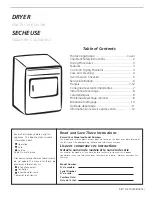
27
CORRECTIVE ACTION
1 “
OH Inverter over-heating
”: The machine must be installed in a place that respects the plate
data. Check cleanliness and functioning of the inverter cooling fans
2 “
OLi Inverter over-loading
”: Optimise the load of laundry.
3 “
OLM Motor overloading
”: Optimise the load of laundry.
4 “
OLR Braking overload
”: Optimise the load of laundry.
5 “
OT Motor torque overload
”: Optimise the load of laundry.
6 “
PH No inverter phase
”: Restore the electric connection.
7 “
FU Inverter inlet fuse
”: Contact the local after-sales centre.
8 “
OP1 No communication
”: Contact the local after-sales centre.
9 “
OP2 No communication
”: Contact the local after-sales centre.
10 “
BF No communication
”: Contact the local after-sales centre.
11 “
OHS Inverter over-heating
” The machine must be installed in a place that respects plate
data. Check cleanliness and functioning of the inverter cooling fans
12 “
LF Inverter limit condition
” Optimise the load of laundry.
13 “
SHC Motor short circuit
” Contact the local after-sales centre.
9.3 MANAGEMENT OF THE HISTORIC ALARMS
Historic alarms are managed in the SERVICE menu, under
the 1st level password, which allows to trace the last ten
events recorded by the G400 DRY control. By entering in this
parameter the machine allows to consult from the last error
signalled to the tenth one in sequence.
ATTENTION! The date and time of the event are NOT
memorised.
10. INFORMATION REGARDING PARTICULAR
SYSTEMS FOR USE AND PROTECTION.
10.1 INSTRUCTIONS FOR THE MAINTENANCE/REPAIR
TECHNICIAN AND IN ORDER TO LOCALISE FAULTS.
10.1.1 IF THE MACHINE DOES NOT FUNCTION
• The master isolating switch on the wall is inserted and
voltage reaches the machine.
• The gas or steam and condensate gate valves are open
(for models with gas or steam heating respectively).
• The gas or steam pressure is sufficient (for models with
gas or steam heating respectively).
• The door must be closed.
• The filter hatch must be closed.
• The fluff filter must be clean.
• The START button has been pressed fully home; a “beep”
must be heard to confirm.
• No alarm has intervened (see Alarms Functioning).
• The load of laundry does not exceed drum capacity (see
technical data table according to the type of dryer).
• Make sure that the electric power company has not
inverted the three-phase power supply phases on
input to your building. In this case have them restored
by the electricity after-sales assistance or by an expert
electrician.
ONCE CHECKED AND THESE OPERATIONS ACTIVATED AND
THE FAULT PERSISTS, CALL THE AUTHORISED AFTER-SALES
CENTRE OR ALTERNATIVELY OUR DEALER (SEE THE LAST
PAGE OF THE MANUAL).
10.1.2 ANOMALIES LINKED TO EXTRACTION
If the blocked filter signal is given continuously and it is clearly
clean, check the following.
1. The direction of rotation of the extractor is correct.
2. The mist evacuation flue is in good working order and
satisfies the minimum features for installation described
in this manual.
3. The attachments of the pressure switch pipes and the
pipes themselves are clean along their entire length and
do not have holes or cracks that jeopardise sealing.
4. If necessary, repeat the calibration procedure described
in this manual.
5. If the signal persists, consult the authorised after-sales
service.
10.1.3 IF DRYING TIME IS TOO LONG.
• The residual humidity in the laundry, before loading
must be equal to the residual humidity after spinning at
1000rpm or equal to about 50 ÷ 60%.
• The flue is too long causing a noteworthy increase in
temperature in proximity of the safety thermostat that
intervenes repeatedly blocking heating.
• The cycle selected is inadequate (times, temperature and
parameters).
• The amount of laundry loaded is larger than the value
indicated for this type of machine in the technical data
table.
• The steam pressure must be sufficient to return within
the machine plate data (for models with steam heating).
ONCE CHECKED AND THESE OPERATIONS ACTIVATED AND THE
FAULT PERSISTS, CALL THE AUTHORISED AFTER-SALES CENTRE
OR ALTERNATIVELY OUR DEALER (SEE THE LAST PAGE OF THE
MANUAL).
10.1.4 THE LAUNDRY IS TOO DRY
• The laundry may have been inserted with humidity lower
than normal.
• The cycle selected is inadequate (times, temperature and
parameters).
Summary of Contents for EB10
Page 38: ...38...















































